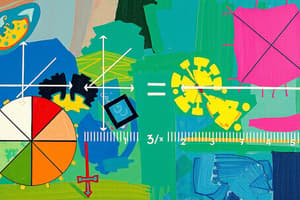Podcast
Questions and Answers
What does the numerator in a fraction represent?
What does the numerator in a fraction represent?
- The value of the whole number
- The total number of parts in the whole
- The relationship between the numerator and denominator
- The number of parts being considered (correct)
When is a fraction considered proper?
When is a fraction considered proper?
- When it can be simplified to a whole number
- When it has both a numerator and denominator
- When its numerator is equal to its denominator
- When its numerator is less than its denominator (correct)
What is an equivalent fraction of 1/2?
What is an equivalent fraction of 1/2?
- 1/3
- 4/8 (correct)
- 3/4
- 2/5
How would you simplify the fraction 8/12?
How would you simplify the fraction 8/12?
In sports, a score of 3 out of 5 games won would be represented as which fraction?
In sports, a score of 3 out of 5 games won would be represented as which fraction?
Flashcards are hidden until you start studying
Study Notes
Identifying Fractions
- Definition: A fraction represents a part of a whole or a ratio between two numbers.
- Components:
- Numerator: The top number, indicating how many parts are considered.
- Denominator: The bottom number, indicating the total number of equal parts in the whole.
- Types of Fractions:
- Proper Fractions: Numerator < Denominator (e.g., 3/4)
- Improper Fractions: Numerator ≥ Denominator (e.g., 5/3)
- Mixed Numbers: A whole number combined with a proper fraction (e.g., 1 1/2)
- Equivalent Fractions: Different fractions that represent the same value (e.g., 1/2 = 2/4).
- Simplifying Fractions: Reducing fractions to their simplest form by dividing the numerator and denominator by their greatest common divisor (GCD).
Real-life Fraction Examples
- Cooking: Using fractions in recipes (e.g., 1/2 cup of sugar).
- Measurement: Rulers and tape measures often show fractions (e.g., 1/4 inch).
- Time: Representing portions of an hour (e.g., 30 minutes is 1/2 hour).
- Money: Understanding cents as fractions of a dollar (e.g., 25 cents is 1/4 of a dollar).
- Sports: Scoring in games (e.g., a team wins 3 out of 5 games, represented as 3/5).
Identifying Fractions
- A fraction illustrates a portion of a whole or the ratio between two quantities.
- Numerator: Indicates the number of parts taken from the whole.
- Denominator: Indicates the total number of equal parts comprising the whole.
- Proper Fractions: Occur when the numerator is less than the denominator (e.g., 3/4).
- Improper Fractions: Arise when the numerator is greater than or equal to the denominator (e.g., 5/3).
- Mixed Numbers: Combine a whole number with a proper fraction (e.g., 1 1/2).
- Equivalent Fractions: Fractions that denote the same quantity despite having different numerators and denominators (e.g., 1/2 = 2/4).
- Simplifying Fractions: Process of reducing fractions to their simplest form by dividing both the numerator and denominator by their greatest common divisor (GCD).
Real-life Fraction Examples
- Cooking: Recipes often require fractional measurements, such as 1/2 cup of sugar.
- Measurement: Rulers and tape measures frequently display fractions, for instance, 1/4 inch.
- Time: Fractions can represent segments of time, with 30 minutes equating to 1/2 hour.
- Money: Cents are fractions of a dollar; for example, 25 cents is 1/4 of a dollar.
- Sports: Winning records can be expressed as fractions, such as a team winning 3 out of 5 games, represented as 3/5.
Studying That Suits You
Use AI to generate personalized quizzes and flashcards to suit your learning preferences.




